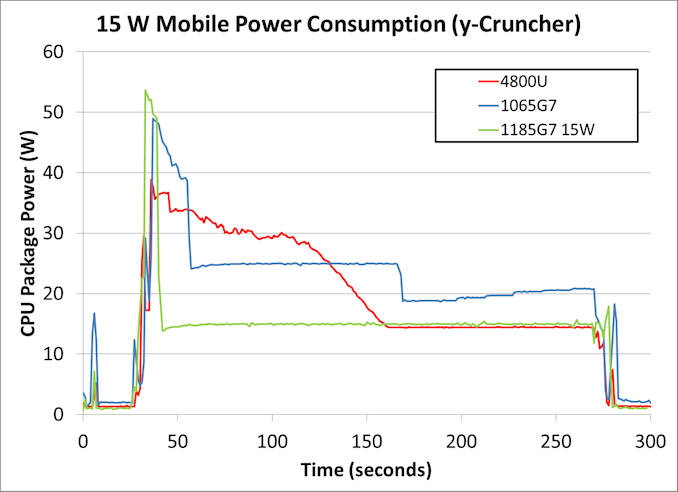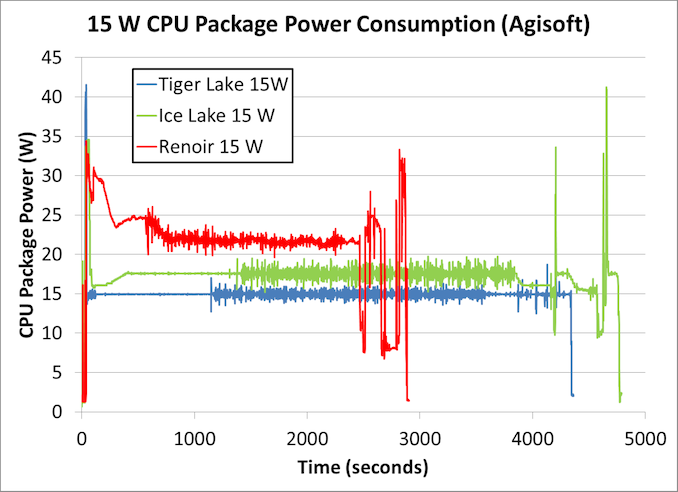Intel’s Tiger Lake 11th Gen Core i7-1185G7 Review and Deep Dive: Baskin’ for the Exotic
by Dr. Ian Cutress & Andrei Frumusanu on September 17, 2020 9:35 AM EST- Posted in
- CPUs
- Intel
- 10nm
- Tiger Lake
- Xe-LP
- Willow Cove
- SuperFin
- 11th Gen
- i7-1185G7
- Tiger King
Comparing 15 W TGL to 15 W ICL to 15 W Renoir
Despite the hullaballoo with the 28 W numbers on Tiger Lake, we suspect that most OEMs will still be positioning the hardware inside chassis built for the 15 W ultraportable market. This is where most of Intel’s OEMs have had success over the last decade, as the lower cooling requirements allow for a more user-friendly design. At 28 W, there is more of a cross-over into laptops that have discrete graphics options, and the main company that has succeeded in offering 28 W laptops without discrete graphics has been Apple - most Intel partners, if they want discrete graphics, end up looking at the 45 W processors with more cores.
So in that respect, our main battle should occur between the products built for 15 W. To that end we have been able to put the three together that will command this holiday season’s offerings: Ice Lake, Tiger Lake, and AMD’s Renoir.
- For our Ice Lake system, we have the Microsoft Surface Laptop 3. This has the top-of-the-line quad-core Core i7-1065G7, along with 16 GB of LPDDR4X-3733. Base 1.3 GHz, Turbo 3.9 GHz. Because this is an OEM design, Microsoft have determined the PL1 and PL2 values, and so they might be different from a ‘base’ design, however this is data from a real system.
- The Tiger Lake system is our Reference Design from Intel, running the quad-core Core i7-1185G7 at 15 W TDP mode. It has 16 GB of LPDDR4X-4266. Base 1.8 GHz, Turbo 4.8 GHz.
- Our AMD Renoir system is one of the most premium examples of AMD’s Ryzen Mobile in a 15W form factor, the Lenovo Yoga Slim 7 with the eight-core Ryzen 7 4800U processor. Even when set to the highest performance mode, the system still operates with a 15 W sustained power draw. It comes equipped with 16 GB of LPDDR4X-4266. Base 1.8 GHz, Turbo 4.2 GHz.
Compute Workload
For our 15 W comparisons, we can look again at the same benchmarks as the previous page. First up is y-Cruncher, an AVX2/AVX512 compute workload that tasks the CPU and the memory by calculating 2.5 billion digits of Pi, and requires ~11 GB of DRAM.
As we saw on the previous page, our Tiger Lake system in green at 15 W turbos up to ~53 watts before very quickly coming down to 15 W for the rest of the test.
The Microsoft Surface Laptop 3, by virtue of an OEM system, has different behavior - it turbos for longer, settles into a short turbo limit of 25 W, and then after about two minutes comes down to 20 W. The system then appears to opportunistically up the power draw until the end of the test, likely due to detecting extra thermal headroom.
The AMD Renoir processor does not turbo as high, peaking at only 38.9 W. Over the course of the next 100 seconds or slow, we see a small ramp down to just under 30 watts, before a more consistent decline over 30 seconds to 15 W, before staying at 15 W for the full test. The Renoir here has eight cores rather that four, but is running AVX2 rather than AVX-512 code.
The results are as follows:
- Ice Lake: 233 seconds, for 6072 joules, averaging 26.1 W
- Tiger Lake: 241 seconds for 4082 joules, averaging 17.0 W
- Renoir: 234 seconds for 5386 joules, averaging 23.0 W
All three systems perform the test in roughly the same amount of time, however the Tiger Lake system is very much ahead for efficiency. Tiger Lake effectively shaves off a third of the power from the previous generation Ice Lake system. We weren’t expecting this much of a jump from Ice Lake to Tiger Lake, but it would appear that Intel has done some work on the AVX-512 unit, and is putting that new high-performance transistor to use.
Professional ISV Workload
Moving onto the Agisoft test - as mentioned on the previous page, this is a 2D image to 3D modeling workflow where the algorithm comes in four stages, some of which prefer full multi-thread throughput, while others are more frequency and memory sensitive.
First, the Renoir finishes in almost half the time, mostly due to the fact that it has double the number of cores - there is no AVX-512 codepath in this test, and so all the processors rely on a mix of SSE, AVX, and perhaps some AVX2. That aside, the turbo behavior of Renoir is very interesting - we get almost 10 minutes of higher-than-base performance before the algorithm sets into a routine, hovering around 22 W. Because this test doesn’t attack the vector units as hard as the previous test, it may be a case that the Renoir system can manage the power distribution a bit better between the eight cores, allowing for the higher turbo.
Between the Ice Lake and the Tiger Lake, from the graph it would appear to be a double win for Tiger Lake, finishing in a shorter time but also consuming less power. The results are:
- 15 W Renoir: 2842 seconds for 62660 joules
- 15 W Ice Lake: 4733 seconds for 82344 joules
- 15 W Tiger Lake: 4311 seconds for 64854 joules
In this case, it’s a win for Renoir - a lot shorter time, and better power to boot, derived from the eight cores built on TSMC 7nm. Tiger Lake still represents a good jump over Ice Lake, offering 10% better performance at only 79% of the power, or a 13% increase in performance efficiency.












253 Comments
View All Comments
Spunjji - Friday, September 18, 2020 - link
Really not sure what you're chatting about here - the Renoir system on test uses LPDDR4X at the same frequency as the TGL system.The only really relevant query would be over the thermal design of the system, but even then, the power consumption charts (did you check them?) show that the TGL system sticks to its limits in 15W mode.
Basically it feels like you're scrabbling for complaints that aren't really justified.
proflogic - Thursday, September 17, 2020 - link
*yawn* Looks like I'll skip another generation. It looks like PCIE ACS started getting into root ports with ICL, so I was hoping for more impressive performance gains with TGL (probably shouldn't have expected much with still having 4 cores). For my intended workloads, this generation isn't worth the investment. YMMV.I'm probably waiting for whenever AMD gets USB4 into their platform.
ksec - Thursday, September 17, 2020 - link
Those GPU benchmarks looks very strange. And some are missing the AMD 15W variants others are missing Intels.....So the graph looks very unbalanced.
IanCutress - Thursday, September 17, 2020 - link
Limited time to test. I set the gaming benchmark script to run overnight, and until I actually look at the output data, I won't know if a particular test has failed or not run properly. Then Intel asked for the system back on Sunday.I technically went on holiday from Monday (booked ages ago), had to take the Lenovo AMD laptop with me to test in the hotel room, and lost two days of holiday to writing up the review. Turns out in the middle of nowhere you can't really download borderlands 3 in a reasonable time scale.
ksec - Friday, September 18, 2020 - link
Thanks Ian on the hard work.I dont know how the publisher or other people thinks. Personally I wish this would be first thing spelled out in the article. It also felt like Intel is rushing things a little bit this time.asfletch - Friday, September 18, 2020 - link
Wow you can still travel? Not sure whether envious...(Australian here, locked down to 5km radius).Spunjji - Friday, September 18, 2020 - link
Damn! That's dedication, but I sincerely hope you get some proper time out soon to make up for it. 👍MCPicoli - Thursday, September 17, 2020 - link
Locking security fixes behind "premium" versions? How about NO?ballsystemlord - Saturday, September 19, 2020 - link
I agree. Security only for businesses is stupid.WaltC - Thursday, September 17, 2020 - link
Wake me in six months if and when you tag a retail unit to test...;) Intel is so thoughtful to send out unfinished units for Intel-managed reviews with pre-conditions and canned scenarios to try and make it appear to equal or exceed AMD's presently shipping, finished products. Yawn...what else is new?